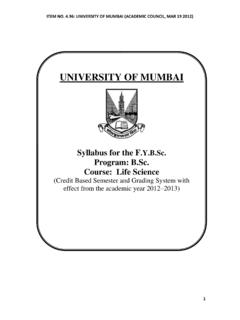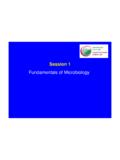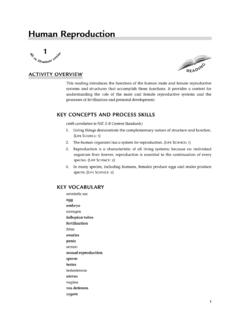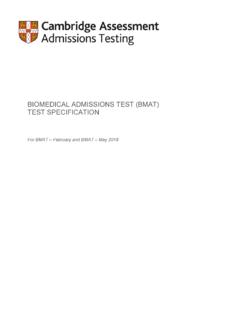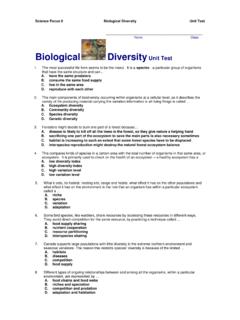Transcription of UNIVERSITY OF MUMBAI - jaihindcollege.com
1 ITEM NO. : UNIVERSITY OF MUMBAI (ACADEMIC COUNCIL, MAR 19 2012 1 UNIVERSITY OF MUMBAI Syllabus for the Program: Course: Life Science (Credit Based Semester and Grading System with effect from the academic year 2012 2013) ITEM NO. : UNIVERSITY OF MUMBAI (ACADEMIC COUNCIL, MAR 19 2012 2 NEW SYLLABUS OF IN LIFE SCIENCES (SEMESTER BASED CREDIT AND GRADING SYSTEM) TO BE IMPLEMENTED FROM THE ACADEMIC YEAR 2012-2013 T H E O R Y SEMESTER I USLSC 301 Comparative Physiology (Total Lectures: 45) (The number of periods for each topic is given in brackets) PREAMBLE.))
2 Comparative approach to Physiology should indicate and remind students that in isolated, narrow subdisciplines there is also a wealth of information that can be obtained from unrelated and distant organisms . Thus comparing and contrasting diverse mechanisms provides a cohesive understanding of physiology. Further understanding normal physiology also helps in treatment of diseases which leads to its alteration. Control and Coordination Unit I Homeostatic mechanisms and cellular communication Control systems in homeostasis and components of homeostatic control (1) An overview of cell signalling and biochemical basis of cell signalling - Release and transport of chemical messengers, communication of signal to target cell (5) Cell signalling in the nervous system and endocrine system [eg.]
3 Peptide hormones, steroid hormones and amines (catecholamine and thyroid hormones)] -- Regulation of receptors (up and down regulation) --- Regulation of cell signalling: 1st , 2nd and 3rd order feedback mechanisms. (3) An overview of endocrine glands and their hormones (3) Pineal, Hypothalamus, Anterior pituitary, Thyroid, Parathyroid, Pancreas, Adrenal cortex, Testis and Ovary. Arthropod steroid hormone: ecdysone. Plant hormones and their role in Homeostasis (3) Ethylene, Cytokinin, Abscisic acid, Giberillic acid, Auxins (structure and functions) Unit II Control and Coordination in plants and animals Animals: The Nervous System CNS and PNS overview (2) Nature of the Nerve Impulse Resting potential, Action Potential, Transmission of Nerve impulses and synapses (5) Phylogenetic development of the Nervous System nerve net, nerve plexus and ganglionated nervous system in hydra, starfish and earthworm.
4 (1) Behaviour and behavioural adaptations Innate and learned behaviour (habituation) (2) ITEM NO. : UNIVERSITY OF MUMBAI (ACADEMIC COUNCIL, MAR 19 2012 3 Plants: Plant movements Tropisms, Taxes, Nasties and Kinesis discuss with reference to a hormone eg. auxins (3) Circadian rhythm in plants using suitable example. (2) Unit III Reproduction and Development Endocrine regulation of reproduction in human: (7) General principles of gametogenesis in human reproductive system Sex determination : Role of SRY gene and Aromatase Sex determination in plants Eg.)
5 Maize Sex reversal and role of environmental factors in sex determination. Sex differentiation of gonads, internal and external genitalia. Ovarian and testicular functions, puberty and regulation of uterine changes in menstrual cycle, menopause, pregnancy, parturition, lactation. Artificial regulation of reproduction: Use of contraceptive methods An overview of sexual and asexual reproduction : (3) Asexual reproduction: Parthenogenesis in insects eg. Wasp/Honey bee/Ants Fig wasp / Gall wasp : An interesting plant-animal interaction for reproduction Alternation of generations in plants (sporophyte and gametophyte stage in fern) : (2) Fruiting body formation in slime mold (Dictyostelium discoideum) Gametogenesis and early development in Plants and animals: (3) Microsporogenesis and megasporogenesis.
6 Types of ovules and fertilization. Development of embryo in moncot and dicot plants Type of egg in frog: Cleavage and development of embryo in frog. USLSC 302 Life processes at the tissue, organ and organism levels A Biochemical Approach (Total Lectures: 45) PREAMBLE: To understand the detailed functioning of a cell it is necessary to study it at the molecular level. Basic biochemical processes in cells and tissues and their regulation and integration are the mainstay of a normal functional cell. UNIT I Enzymes and their environment (Total 15) A.
7 Water, pH, Buffers a review, stressing on the significance (3) B. Enzymes (12) ITEM NO. : UNIVERSITY OF MUMBAI (ACADEMIC COUNCIL, MAR 19 2012 4 1. Extraction, purification and Specific activity (Mention Techniques : Dialysis, Gel-filtration, Ion-exchange, Affinity chromatography and Spectrophotometry) 2. Classification 3. Effect of pH and Temperature 4. Co-enzymes and co-factors 5. Kinetics 6. Enzyme Inhibitors, Activators and feed-back 7. Allosteric enzymes and their significance in metabolic regulation UNIT II Metabolism - Energy from Carbohydrates : (Total 15) A.)
8 Carbohydrates - Catabolism (9) 1. Glycolysis process and metabolic regulation 2. Citric Acid Cycle a)Process and regulation. b) Importance as a central amphibolic pathway unifying all primary biological processes. c) Anaplerosis B. Bioenergetics : 1. Electron Transport System (2) i. Localisation and ii Sequence of electron transporters 2. Oxidative Phosphorylation (4) i.
9 Mitchell s Chemiosmotic Hypothesis ii. ATP synthesis iii. Control of respiration, uncoupling and metabolic poisons UNIT III Metabolism - Energy from Lipids and Proteins : (Total 15) A. Lipids - Catabolism : (7) 1. Lipolysis 2. Role of Carnitine in mitochondrial permeability 3. Beta Oxidation of fatty acids and integration into Kreb s cycle 4. Ketone bodies and their significance B. Amino Acids - Catabolism : (8) 1.
10 Protein Degradation liberating amino-acids 2. Deamination & ammonia disposal by Urea cycle. 2. Decarboxylation & integration into Kreb s cycle USLSC 303 Population approach : population and communities as regulaory unit PREAMBLE: As T. Dobzansky said Nothing in biology makes sense unless seen in light of evolution . The first two units are an introduction to basics in evolution and its modern syntheses with focus of integrating genetics and population. ITEM NO. : UNIVERSITY OF MUMBAI (ACADEMIC COUNCIL, MAR 19 2012 5 Quantitation is an important aspect of modern biology.)
